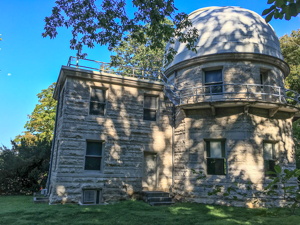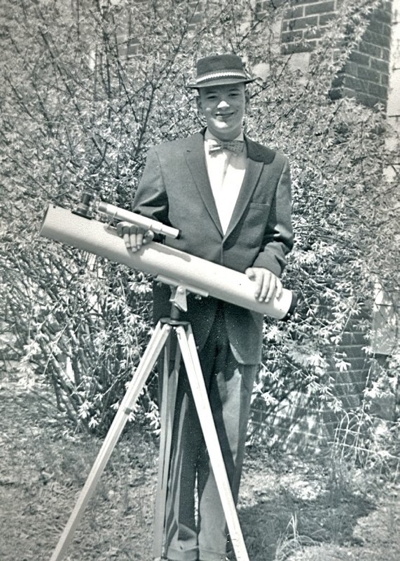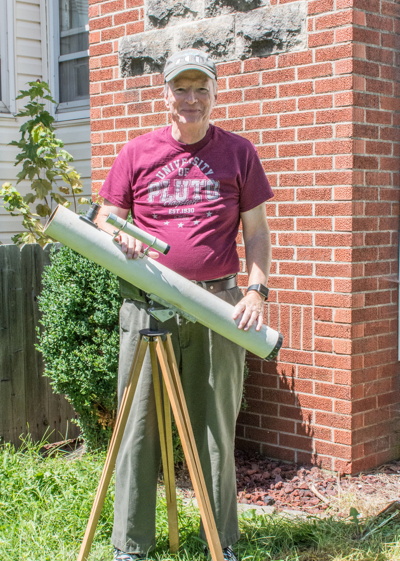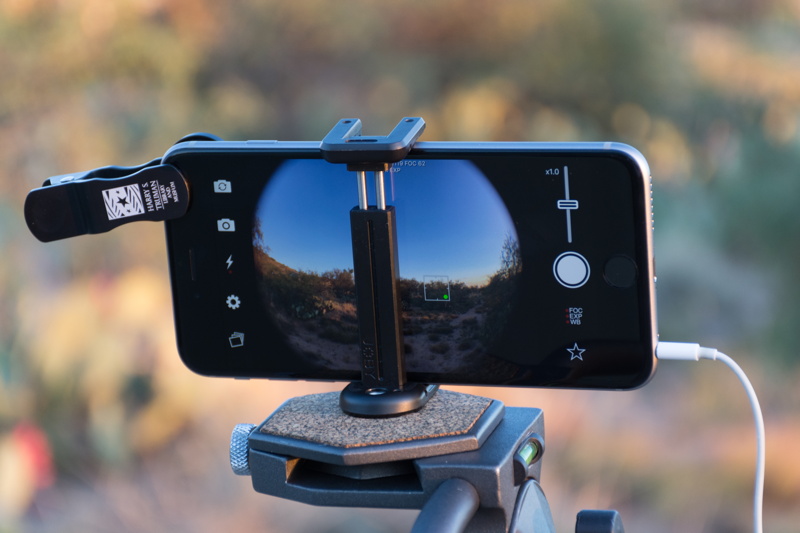VLA & Kirkwood Observatory Visits; 3" Telescope 1962 vs 2016;
iPhone Fisheye Astrophotography; More LX600 Work
Posted: 31 August 2016
As forecast, Wednesday, 10 August 2016, had Monsoon storms in the area and cloudy skies. We received only 0.05" rain. Before sunrise on Thursday, 11 August, a Monsoon storm came through dropping 0.5" rain. The sky cleared out as sunset approached but due to my leaving on a trip the next day I had to miss the best night of the Perseid meteor shower. I was in Albuquerque on Saturday, 27 August; I was prepared to photograph the very close conjunction of Jupiter and Venus that night with my 600mm lens but the sky was cloudy (it was clear at Cassiopeia Observatory). I returned home on Monday, 29 August, but I did not open the observatory that night due to being tired from the long drive. Tuesday night was forecast to be clear, but monsoon storm clouds showed up in the afternoon with occasional thunder.
While on travel I visited two observatories. The first one was the Very Large Array (VLA) in New Mexico on 13 August:

Click on photo to view the photo album
The second was Kirkwood Observatory and the Astronomy Department at Indiana University in Bloomington, Indiana.

Click on photo to view the photo album
I also visited my hometown (Seymour, Indiana) and, with the tenant's persission, I recreated a photograph of me with my Edmund Scientific 3" Newtonian Telescope taken outside my home in 1962 with a similar photo taken in 2016:


That was a lot of fun and brought back many memories.
I hope to get more photos from the trip posted soon.
|
Open: Tuesday, 30 August 2016, 1831 MST Temperature: 94°F |
Session: 1006 Conditions: Mostly clear |
Equipment Used:
12" f/8 LX600 w/StarLock
Wired AutoStar II handset
2" 24mm UWA eyepiece
2" 9mm 100° eyepiece
Camera:
iPhone 6s Plus
Finally got back in the observatory after an absence of three weeks.
SYNCed observatory clock to WWV.
Part of this night's session was to test out a new 3-in-1 clip-on lens for smartphones that I purchased at the Harry S. Truman Library and Museum gift shop in Independence, Missouri, for $12. The kit includes a fisheye lens, a wide-angle lens, and a macro lens, and a nice soft case:


Here is how the fisheye lens looked on my iPhone 6s Plus before sunset:


1850 MST: sunset. Some clouds were in the western sky:

Venus was shining brightly low in the western sky, as seen near the center of this photo (taken at 1919 MST):

Mouseover or tap on image for label
1853 MST: LX600 ON, StarLock OFF, High Precision OFF.
1855 MST: viewed Mercury, 102X. Its wide crescent phase was barely discernible due to the planet's low altitude in the western sky. Then viewed Venus, also low in the sky, 102X. Its gibbous phase was obvious. Next, viewed Jupiter, very low in the west, 102X. The equatorial belts were visible.
1906 MST: slewed to Mars and viewed it at 102X. Some dark areas were visible. Switched to 271X. Unfortunately seeing was not very good. And the telescope was still cooling down. Then viewed Saturn, 271X. The view was actually pretty good. The moon Titan was visible. But what got my attention was that Cassini Division was visible nearly completely around the Ring as the ring system was tilted so much. I believe this was the first time I had seen this. 1914 MST: the moon Rhea was visible, and then a few seconds later the moon Tethys appeared as the sky darkened. 1921 MST: the moon Dione appeared.
1931 MST: slewed to M108 (galaxy). I wanted to try to observe the just reported possible supernova in the galaxy. M108 was low in the northwestern sky so the chances were slim of getting the supernova, if it exists. The galaxy was not yet visible against the twilight sky. 1938 MST: High Precision ON. Did a GOTO M108; still not visible. 1950 MST: galaxy was now faintly visible using averted vision, 102X. 1958 MST: a star was noticeable near the center of the galaxy, but I was unable to determine if this was the supernova. The galaxy was now getting into a tree. I compared the view through the 12" telescope with an image I took of M108 in March 2015. A "bright" star was visible near the center of the galaxy in that image, so I doubt that I was seeing a new supernova. Unfortunately, due to M108 getting into the tree I was unable to acquire any images of M108 this night. 2012 MST: gave up on M108.
Slewed to Saturn. Clouds were now in the south and west sky. Began setting up for iPhone sky astrohotography. I would use the NightCap Pro iOS app. I mounted the iPhone on a camera tripod using the "grip" from my GorillaPod. I then began taking a series on images using the iPhone fisheye lens. With the lens attached getting a precise focus on stars or even distant trees was nearly impossible. Only one of the several images I took turned out reasonably well, but still slightly out-of-focus. At least, the planets Saturn and Mars (on the right) and the Milky Way (center) are visible in this Long Exposure mode, 149 seconds exposure:

I need to do more tests of astrophotography with the clip-on lens set.
I was able to take this fisheye photo of the observatory using NightCap Pro:

2115 MST: final look at Saturn, 102X. I then began preparing to do a StarLock Auto Drift Alignment. Moved the dome onto the PZT. StarLock ON. 2122 MST: began the Drift Align. After 188 seconds the StarLock reported that no adjustment of the wedge Azimuth was needed. After another 188 seconds the StarLock reported that no adjustment in the wedge Elevation (Latitude) was needed either. I had done the StarLock Drift Alignment with the original 12" LX600 back in April 2016. Swapping out the telescope for a replacement did not affect the wedge alignment.
2145 MST: I then began the StarLock automated Right Ascension (RA) Periodic Error Correction (PEC) training for the replacement telescope. 2211 MST: the first RA PEC training was completed. I had hoped to complete the PEC training and two PEC training updates this night, but clouds and breezes became a problem. Will do the two updates on a future session.
Moved the dome off the PZT. 2218 MST: viewed M31 (Andromeda Galaxy) and its companion galaxies M32 and M110, 102X. Lovely view. Then began closing up.
|
Close: Tuesday, 30 August 2016, 2234 MST Temperature: 77°F |
Session Length: 4h 03m Conditions: Partly cloudy, breezy |
Comments are welcome using Email. Twitter users can use the button below to tweet this report to your followers. Thanks.
Cassiopeia Observatory Home Page
Copyright ©2016 Michael L. Weasner / mweasner@me.com
URL = http://www.weasner.com/co/Reports/2016/08/31/index.html
